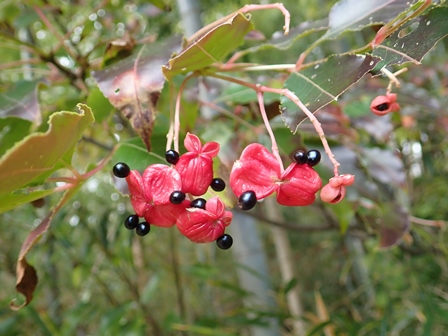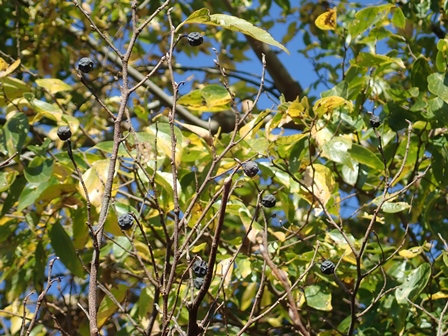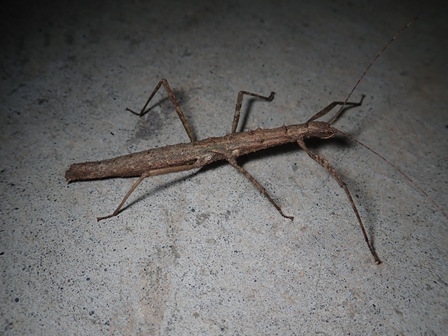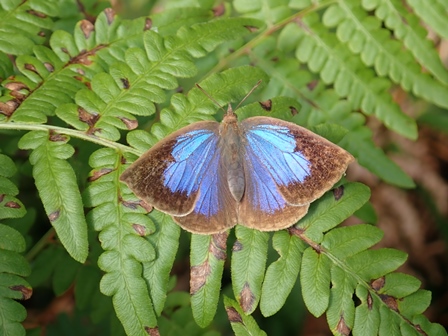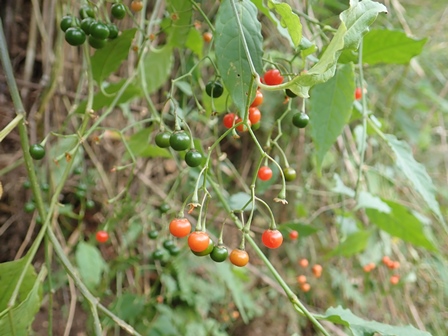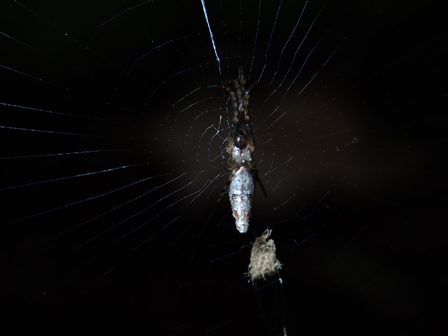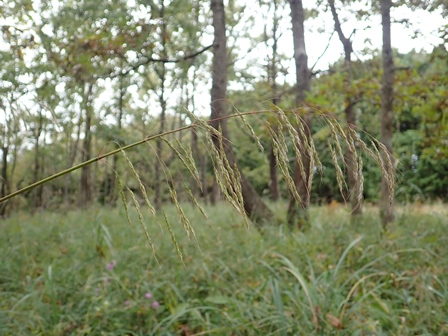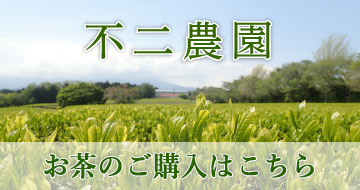フィールド日記
2020年11月
2020.11.27
ゴンズイ
駐車場の近くにゴンズイの木があります。鮮やかな赤色の果実が裂開し、黒い光沢のある種子が見えています。和名の由来はいくつかあり、その一つは、同じゴンズイという名前の魚に由来するという説です。
There is a "Gonzui" tree near the parking area. Its vivid red fruits have dehisced and the glossy black seeds are appearing. There are a couple of ways to explain where the name came from. One of them is that the name came from the fish that is called the same name "Gonzui".
2020.11.26
11月の野鳥の調査
日本野鳥の会東富士副代表の滝道雄先生が11月の不二聖心の野鳥について調査をしてくださいました。調査の報告書が届きましたので、掲載いたします。
2020年11月度の調査で確認された野鳥は下記の通りです。
【特記事項】
2020.11.24
ムクノキ
聖心橋の近くのムクノキに、黒く熟した実がなっていました。実は甘く、昔は子供たちが食べたそうです。動物にとっても冬の貴重な食料になっており、ムクドリはこの木によく集まることが名前の由来といわれています。
A "Mukunoki (ムクノキ)" tree is bearing black ripe fruits near the Seishinbashi bridge. The fruits are sweet, so it is said that children in the past used to eat them. The fruits are also precious food for wild animals. There is a bird called "Mukudori (ムクドリ)" and it is said that the name comes from the fact that they come to this tree to eat the fruits.
2020.11.20
トゲナナフシ
校舎の近くでトゲナナフシを見つけました。名前の通り、体にトゲトゲがあるのが特徴です。普段は木の枝などに擬態して見つけるのが難しいですが、このときはコンクリートの上にいて、目立っていました。
I found a stick insect called "Togenanafushi (トゲナナフシ)" by the school building. The word "toge (トゲ)" in its name means "spine" and they are literally spiny. They usually mimic branches and it is hard to find them, but this time the insect was on the concrete floor so it was outstanding.
2020.11.17
ムラサキシジミ
オークヒルでムラサキシジミを見つけました。普通種ですが、翅は光沢のある青紫で美しいです。手元の図鑑によると、越冬前に翅を広げて日光浴をするとあるので、この個体はこのあと越冬するのかもしれません。
I found a "murasakishijimi (ムラサキシジミ)" butterfly in the Oak Hill. Although they are a common species, their wings are metallic violet and beautiful. My reference book says that they bathe in the sun before the winter, so this one may be going to prepare itself for staying over the winter.
2020.11.13
マルバノホロシ
セカンドオークヒルでマルバノホロシを見つけました。つる性の多年草で、林縁によく見られます。花は8~9月に咲きますが、秋に赤く熟す果実のほうが目立ちます。
I found a "Marubanohoroshi" plant in the Second Oak Hill. They are perennial climbing plants that are often seen at the edges of forests. The flowers bloom in from August to September, but the red fruits maturead in fall are more outstanding.
2020.11.10
ギンナガゴミグモ
ヒノキ林でギンナガゴミグモを見つけました。名前の通り、腹部に銀色の光沢があります。また、網を張るクモはふつう下向きに止まることが多いですが、この仲間は上向きに止まるという特徴があります。
I found a "Ginnagagomigumo (ギンナガゴミグモ)" in the Japanese cypress woodland. The word "Gin (ギン)" in its name means "silver" and its body is actually silver. In general, spiders wait for preys on its web facing downward but this species waits facing upward.
2020.11.06
イシミカワ
セカンドオークヒルでイシミカワを見つけました。草地によくみられる一年草です。茎には逆向きのトゲがあり、他の植物によりかかかりながら生長します。花の後、がくが果実を包み込み、きれいな瑠璃(るり)色になります。
I found "Ishimikawa (イシミカワ)" plants in the Second Oak Hill. They are annual plants that are often seen in fields. Their stems have thorns that face the opposite direction and they grow leaning on other plants. After flowering, sepals wrap their fruits and turn beautiful blue.
2020.11.05
10月の野鳥の調査
日本野鳥の会東富士副代表の滝道雄先生が10月の不二聖心の野鳥について調査をしてくださいました。調査の報告書が届きましたので、掲載いたします。
2020年10月度の調査で確認された野鳥は下記の通りです。
1.ジョウビタキ…2羽
2.トビ…4羽
3.アオゲラ…1羽
4.ハシボソガラス…1羽
5.ハシブトガラス…13羽
6.シジュウカラ…8羽
7.ヒヨドリ…23羽
8.モズ…2羽
9.メジロ…12羽
10.ビンズイ…1羽
11.ウグイス…4羽
12.ヤマガラ…7羽
13.ホオジロ…2羽
14.コゲラ…1羽
15.ノスリ…1羽
16.エナガ…12羽
17.カケス…6羽
18.イカル…1羽
19.ガビチョウ…1羽
20.ソウシチョウ…6羽
【特記事項】
1.駐車場で冬鳥のジョウビタキのオス2羽が、来春までの縄張りを決める争いをしていた。縄張りが決まると、駐車場に止めてある車のサイドミラーに映る自分の姿を、他のジョウビタキだと思い攻撃をする事が有る。サイドミラーに糞が付いていたらジョウビタキの仕業かもしれません。
2.漂鳥のビンズイ1羽が、早くも裏道で見られた。
3.カケスが体育館前のアラカシの実(ドングリ)をくわえて運んで行った。食べるか、保存食として木や石の根元に保存するか興味が湧く。
2020.11.03
アブラススキ
クヌギ林の中にアブラススキが生えていました。名前は花穂から油のような粘液を出すことに由来するようです。確かに、花穂を触るとネバネバしていました。
I found "Aburasusuki (アブラススキ)" plants in the SawTooth oak woodland. "Abura (アブラ)" in its name means "oil" and it comes from the fact that their spikes produce mucus that is similar to oil. Their spikes were actually sticky when I touched them.
- 1 / 1


